This article was medically reviewed by Erik Kramer, DO, MPH. Dr. Erik Kramer is a Board-Certified Primary Care Physician at the University of Colorado. With over 15 years of experience, his clinical interests include obesity and weight management, diabetes care, and preventive care, as well as embracing a holistic approach to primary care. He received his Doctorate in Osteopathic Medicine (D.O.) from the Touro University Nevada College of Osteopathic Medicine and completed his residency at Central Maine Medical Center. Dr. Kramer is a Diplomate of the American Board of Obesity Medicine.
There are 10 references cited in this article, which can be found at the bottom of the page.
wikiHow marks an article as reader-approved once it receives enough positive feedback. This article has 14 testimonials from our readers, earning it our reader-approved status.
This article has been viewed 1,709,950 times.
Your pulse tells how fast your heart is beating. It also can signal how well your heart is working and even your health and fitness level.[1] It may sound difficult, but checking your pulse is easy and doesn’t require any special equipment. You can check your pulse by hand or by using an electronic pulse meter or heart rate monitor.
Steps
Taking Your Pulse by Hand
-
1Find a timepiece to measure while you count your heartbeats. Gather a watch or find a nearby clock. You’ll need to watch the time as you count your heartbeats. Have a digital or analog watch that has a second hand handy or find a nearby clock so that you can see the time to get the correct pulse rate.[2]
- You can also use a stopwatch or the timer on your phone.[3]
-
2Decide where you want to take your pulse. Choose to check your pulse either on your neck or your wrist. Do whichever feels most comfortable for you or where you can easily find your pulse.[4] You can also take your pulse on the following spots, though it may be more difficult to detect your heartbeat on them:
- Temple
- Groin
- Behind the knee
- Top of the foot
Advertisement -
3Place your fingers in the proper position to feel your pulse. Press firmly but not so hard that you can no longer feel the pulse. Put your index and third finger on either side of your neck to the side of your windpipe to find the carotid artery. If you’re measuring on your wrist, set two fingers between the bone and tendon over your radial artery.[5]
- Be careful not to press to hard over the carotid artery, as this can cause you to become lightheaded.[6]
- Find your radial artery by drawing a line with your finger from below your thumb to your wrist. Then feel for the spot between the wrist bone and tendon for a slight pumping motion.
- Place the flat part of your finger on your wrist or neck to get the most accurate reading. Avoid using your fingertips or your thumb.
-
4Watch your timepiece. Decide if you are going to take your pulse for 10, 15, 30, or 60 seconds. Take out your timepiece so you can do this while you’re counting how many times your heartbeats.[7]
-
5Count your heartbeats. When the clock reaches zero, start counting how many times you feel a pulse or beat on your neck or wrist. Keep counting until your timepiece reaches the number of seconds you chose to tally your heartbeats.[8]
- Let yourself rest for five minutes before taking your pulse to get the most accurate resting heart rate reading. You can also take your pulse while you’re exercising to measure how hard you are exercising.
-
6Calculate your pulse. Note or remember how many heartbeats you counted. Your pulse rate is measured in beats per minute.[9]
- For example, if you counted 41 for 30 seconds, double it to get 82 beats per minute. If you counted for 10 seconds, multiply the beats counted by 6, and if you counted for 15 seconds, multiply by 4.
Using a Monitor to Measure Your Pulse
-
1Get an electronic pulse meter. Use an electronic pulse meter if you have trouble measuring your pulse by hand, you want to check during exercise without stopping, or if you want a very accurate reading. Purchase or rent one at a local medical supply store or another large retailer. Use a smart watch or download a smartphone app to measure your pulse if you have them. Some features to look for include:[10]
- Having a cuff or strap that fits you
- Having a display that is easy to read
- Fitting your needs and budget
- Note that using an app for pulse measurements is not always accurate.
-
2Attach the monitor to yourself. Read your product instructions. Then place the monitor on the proper spot to check your pulse. Most monitors are attached at the chest, finger or wrist.[11]
-
3Turn on the monitor power and start it. When you’re ready to check your pulse, activate your monitor. Make sure the numbers read “OO” to start so that you get an accurate reading.[12]
-
4Read your results. Your monitor will automatically stop and display the number when it’s doing with your reading. Check the display and note what you pulse rate is for this specific reading.[13]
- Save any data or measurements from your reading to track your pulse rate over time.
Expert Q&A
Did you know you can get expert answers for this article?
Unlock expert answers by supporting wikiHow
-
QuestionIf I suspect I am experiencing A-fib, what should my pulse exhibit?
 Jennifer Boidy, RNJennifer Boidy is a Registered Nurse in Maryland. She received her Associate of Science in Nursing from Carroll Community College in 2012.
Jennifer Boidy, RNJennifer Boidy is a Registered Nurse in Maryland. She received her Associate of Science in Nursing from Carroll Community College in 2012.
Registered Nurse Atrial fibrillation (or flutter) is a type of arrythmia (irregular heart beat) that usually exhibits as a fast heart rate of over 100 bpm. The pulse can be irregular as well. Sometimes, with Afib, the heart beat feels like it is racing, fluttering, or even too slow. You may or may not have symptoms, which include heart palpitations, confusion, dizziness or lightheadedness, fainting, fatigue, or shortness of breath. These symptoms may come and go. If you suspect you have an arrythmia, and especially if you are experiencing any symptoms, call your doctor. You may require medical treatment.
Atrial fibrillation (or flutter) is a type of arrythmia (irregular heart beat) that usually exhibits as a fast heart rate of over 100 bpm. The pulse can be irregular as well. Sometimes, with Afib, the heart beat feels like it is racing, fluttering, or even too slow. You may or may not have symptoms, which include heart palpitations, confusion, dizziness or lightheadedness, fainting, fatigue, or shortness of breath. These symptoms may come and go. If you suspect you have an arrythmia, and especially if you are experiencing any symptoms, call your doctor. You may require medical treatment. -
QuestionShould my pulse be the same on my wrist as it is on my neck?
 Jennifer Boidy, RNJennifer Boidy is a Registered Nurse in Maryland. She received her Associate of Science in Nursing from Carroll Community College in 2012.
Jennifer Boidy, RNJennifer Boidy is a Registered Nurse in Maryland. She received her Associate of Science in Nursing from Carroll Community College in 2012.
Registered Nurse
-
QuestionIs pulse rate directly related to blood pressure?
 Erik Kramer, DO, MPHDr. Erik Kramer is a Board-Certified Primary Care Physician at the University of Colorado. With over 15 years of experience, his clinical interests include obesity and weight management, diabetes care, and preventive care, as well as embracing a holistic approach to primary care. He received his Doctorate in Osteopathic Medicine (D.O.) from the Touro University Nevada College of Osteopathic Medicine and completed his residency at Central Maine Medical Center. Dr. Kramer is a Diplomate of the American Board of Obesity Medicine.
Erik Kramer, DO, MPHDr. Erik Kramer is a Board-Certified Primary Care Physician at the University of Colorado. With over 15 years of experience, his clinical interests include obesity and weight management, diabetes care, and preventive care, as well as embracing a holistic approach to primary care. He received his Doctorate in Osteopathic Medicine (D.O.) from the Touro University Nevada College of Osteopathic Medicine and completed his residency at Central Maine Medical Center. Dr. Kramer is a Diplomate of the American Board of Obesity Medicine.
Doctor of Osteopathic Medicine
Warnings
- If your heart rate is consistently less than 60 beats per minute and you're not a trained athlete, call your doctor, especially if you're experiencing symptoms such as dizziness, fainting, or shortness of breath.⧼thumbs_response⧽
- Use only gentle pressure when checking your pulse on your neck or wrist. Pressing too hard, especially on the neck, can cause you to become lightheaded and fall.[15]⧼thumbs_response⧽
- Seek medical attention if your resting pulse rate is consistently above 100 beats per minute.[16]⧼thumbs_response⧽
- A normal pulse is steady and regular. If you notice frequent skipped or extra beats, call your doctor, as this could be a sign of a heart problem.[17]⧼thumbs_response⧽
References
- ↑ https://www.heart.org/en/health-topics/high-blood-pressure/the-facts-about-high-blood-pressure/all-about-heart-rate-pulse
- ↑ https://www.cham.org/HealthwiseArticle.aspx?id=hw233473#hw233488
- ↑ https://www.health.harvard.edu/heart-health/want-to-check-your-heart-rate-heres-how
- ↑ http://www.mayoclinic.org/healthy-lifestyle/fitness/expert-answers/heart-rate/faq-20057979
- ↑ http://www.mayoclinic.org/healthy-lifestyle/fitness/expert-answers/heart-rate/faq-20057979
- ↑ https://www.mayoclinic.org/how-to-take-pulse/art-20482581
- ↑ http://www.nhs.uk/chq/Pages/2024.aspx?CategoryID=52
- ↑ http://www.webmd.com/heart/taking-a-pulse-heart-rate
- ↑ http://www.mayoclinic.org/healthy-lifestyle/fitness/expert-answers/heart-rate/faq-20057979
- ↑ https://familydoctor.org/blood-pressure-monitoring-at-home/
- ↑ https://www.lung.org/lung-health-diseases/lung-procedures-and-tests/pulse-oximetry
- ↑ https://familydoctor.org/blood-pressure-monitoring-at-home/
- ↑ https://familydoctor.org/blood-pressure-monitoring-at-home/
- ↑ http://www.mayoclinic.org/healthy-lifestyle/fitness/expert-answers/heart-rate/faq-20057979
- ↑ http://www.webmd.com/heart/taking-a-pulse-heart-rate
- ↑ http://www.mayoclinic.org/healthy-lifestyle/fitness/expert-answers/heart-rate/faq-20057979
- ↑ https://www.hopkinsmedicine.org/health/conditions-and-diseases/palpitations
About This Article
To check your pulse by hand, find a stopwatch, timer, or clock with a second hand. Then, gently press your index and third finger on your neck to the side of your windpipe. Once you feel your heartbeat, start your timer or keep an eye on your watch while you count the number of heartbeats for 30 seconds. Multiply your result by 2 to get beats per minute. For advice from our Medical reviewer on how to get your resting pulse versus active pulse, scroll down!


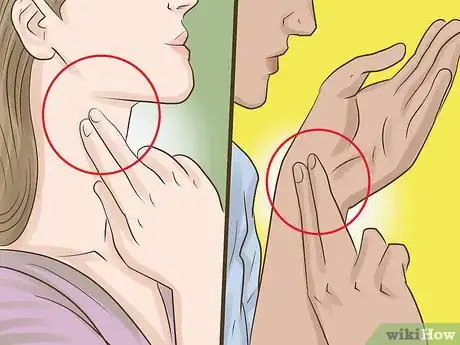
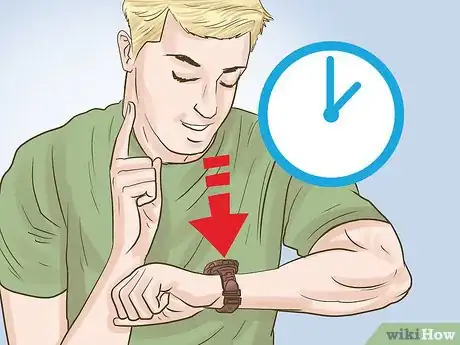

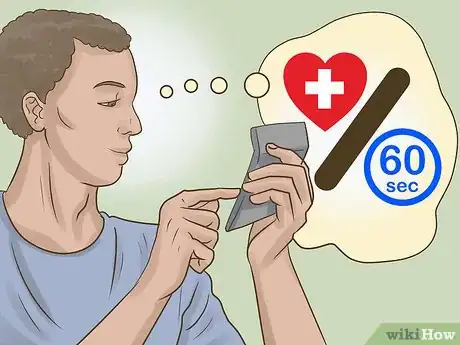
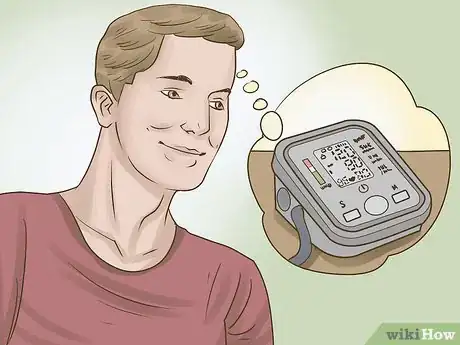
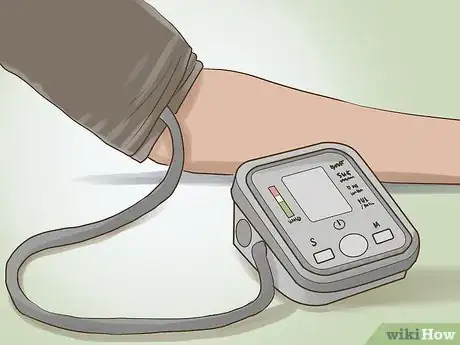
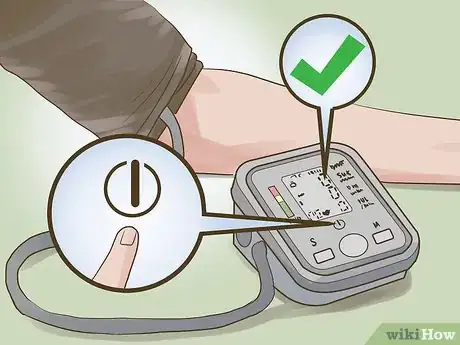






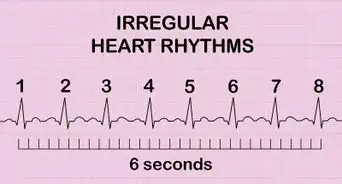

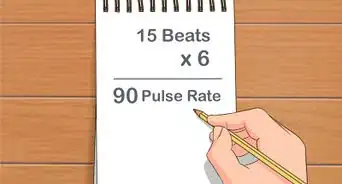
















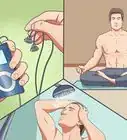







































Medical Disclaimer
The content of this article is not intended to be a substitute for professional medical advice, examination, diagnosis, or treatment. You should always contact your doctor or other qualified healthcare professional before starting, changing, or stopping any kind of health treatment.
Read More...